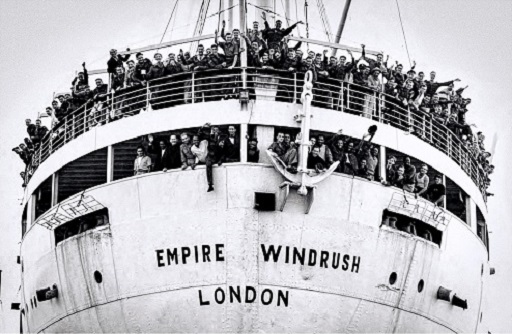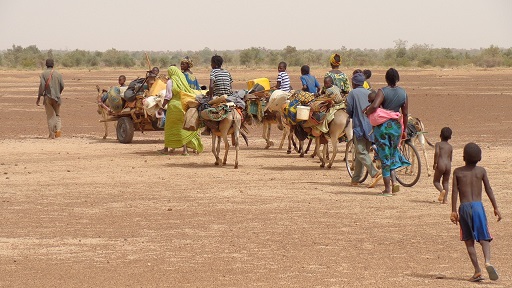2.3 Understanding migration: theories, perspectives and stakeholders
In the last section you were introduced to an Evidence Café ‘in action’ and how
Migration overview
Migration is a major issue in the world. It fills newspapers and websites, politicians discuss it, and you may have migrated yourself – or know people who have. But how common is it, how has it changed, and what does the data tell us about the sorts of migrants we have just discussed, in terms of motives and destinations?
Click on each of the circles in the interactive image below and listen to the audio for each one. To pause the audio, simply double-click.
Migration terminologies
In the previous interactive, you will have seen some ways of categorising migrants. However, these are not watertight and any individual migrant could sit in one or more of these categories, or move between them over time.
While no system of categorisation is perfect, there are three broad categories of migrants: Economic, Displaced and Irregular. Click on each of the circles in the interactive image below to read more about each of these categories. To see a larger version, click on 'view interactive version' below.
Migration theories
Because migration is such an important and complex issue, social scientists have devised many different theories and concepts to try and explain, predict, or manage it. Like any concept these migration theories reflect the assumptions and values of the person developing them, so we also see lots of disagreements! Importantly, there is no ‘right’ answer to the questions of who migrates. why, and with what outcomes? This short course we can’t go through all of these different theories but it does provide you with some sources should you wish to deepen your knowledge of them (see below). Broadly speaking we can summarise the theories depending on what is emphasised most, and we have put these under sociological, economic, geographical and unifying categories.
- Sociological factors are different social factors influencing the migration process from decision-making to integration in the
host country or back to the country of origin, e.g. attitudes to people of a different culture. - Economic factors are those financial in nature or leads to economic benefits for the migrant and their household, e.g. economic situation in a country.
- Geographical theories consider the physical features within the migrant's environment that push or pull the migrants to a particular destination, e.g. good infrastructural development or effects of climate change (drought, floods etc.).
- Unifying factors explain the systems created that help people maintain contacts across regions/places and considers the economic and social benefits of those connections, e.g. social media, mobile phones, sending money to family members.
If you want to find out more about the data and theories you can explore the resources below:
- The Age of Migration [Tip: hold Ctrl and click a link to open it in a new tab. (Hide tip)]
- World Migration Report
- Global Compact for Safe, Orderly and Regular Migration
- International Organisation for Migration, Global Migration Data Analysis Centre (GMDAC)
By now, you should have a basic understanding of the types of
Migration realities
The theories of migration you have just studied need to be put in context. What does mass migration mean for the country that receives these migrants? Why did different migrants in different eras come to that country? How planned were these flows? Every context is different. But equally we can see similarities between places that we might not have thought share the same issues. The video in Activity 2.1 revealed the frustration of the migrant business person. Official data on migrant numbers and directions can be daunting; it’s hard to imagine what millions of people look like and dealing in such big numbers takes attention away from the very real lived experiences of migrants, or those seeking to help them.
Let’s look very briefly at the UK and Kenya. What are the similarities and differences between the migration flows to these two countries?
The UK
Migration to the UK has a very long history, though it has accelerated following the decolonisation of the British Empire. In terms of the theories of migration, these post-colonial flows were very much about economics (Hansen, 2000): the UK was rebuilding after the Second World War and the government needed labour to do this. Migrants from Africa, South Asia, Europe and The Caribbean arrived to work in sectors like transport, healthcare and manufacturing. Sociologically, many of these migrants came from countries formerly within the British Empire, and so had been educated under a British system. For example, many spoke English and so could work in the UK without having to learn another language. During the 1950s and 60s, migrants were often men, travelling ahead to build a new life in Britain so that eventually their spouses were able to join them. Yet they maintained connections with their home countries, with transport and communications technologies making this easier over time. However, these migration flows weren’t unproblematic, with prejudice raised against some of these migrants even though they were supposedly helping the UK to rebuild (Gilroy, 1987; Hansen, 2000).
Kenya
Kenya lies in the east of Africa and has long been a hub for migration. As such the country generates outward migrants but it is also a destination for many migrants from across the East African region and beyond. Kenya is also a transit country that international migrants, mostly from within the African continent, move through as party of a longer migration journey (IOM, 2015). However, the most dominant form of migration is internal, as men and women move to cities in search of opportunities lacking in their rural areas. The rural areas were often underdeveloped with limited resources and services which pushed many to migrate; that is economic factors dominated (National Council for Population and Development, 2013). Initially migration was primarily by men, especially to supply labour during the colonial era. Women migrated in smaller numbers but were unable to secure the same opportunities as men, which reflects certain social values around gender and work. Since Kenya became independent in 1963, migration restrictions have been removed, leading to increasing numbers of people moving from the country to the cities. This pattern continues today.
Since the early 1990s Kenya has also become a
When we compare migration to the UK and Kenya, we see that many of the migrants were economic migrants: people looking for work to improve their lives. These migration flows are also gendered, with men and women not always travelling together or being expected to do the same things. While the UK has taken refugees, particularly after the Second World War ended, these numbers have declined over the past few decades. But for Kenya, refugee inflows are high and have been for some years, which reflects conflict and instability in the Horn of Africa.
2.2 Evidence Café process and discussion objects


